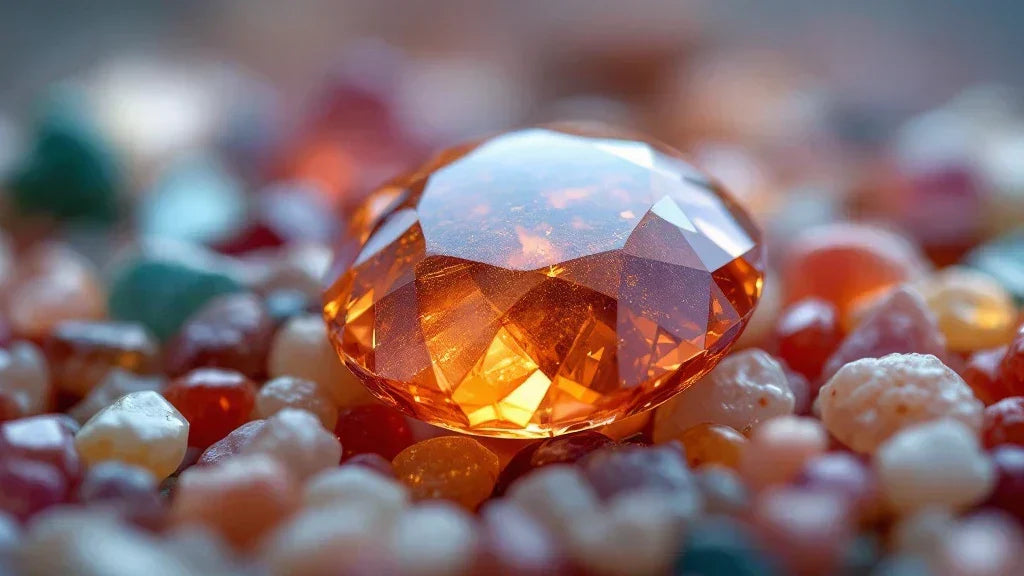
Lab-Grown vs. Natural Gemstones: What’s the Difference?
Share
One of the most common questions when choosing a gemstone is: What’s the difference between lab-grown and natural gemstones? While both share the same chemical composition, optical properties, and stunning beauty, there are key distinctions in their formation, pricing, and long-term value.
If you're considering a lab-grown gem, understanding how it compares to its natural counterpart will help you make an informed decision.
Jump to Section:
- Chemical & Optical Properties
- Clarity & Color Consistency
- Durability & Hardness
- Resale Value & Pricing
- Ethical & Environmental Differences
- Certification & Identification
- Market Trends & Consumer Insights
- FAQs
- Conclusion
Chemical & Optical Properties
Lab-grown gemstones are not fake—they are chemically and physically identical to natural gemstones. Both have the same hardness, brilliance, and colour properties. The key difference lies in how they form:
- Natural gemstones take millions of years to form underground under heat and pressure.
- Lab-grown gemstones are created in controlled conditions that replicate this natural process within a fraction of the time.
The result? Visually, they are identical to the naked eye.
Clarity & Color Consistency
- Lab-grown gemstones tend to have fewer inclusions and more consistent colour due to controlled growth conditions.
- Natural gemstones develop with unique imperfections and slight colour variations, making each stone one of a kind.
If you want a flawless gemstone with vivid colour, a lab-grown gemstone is often the better choice. However, if you appreciate the individuality of nature-made imperfections, a natural gemstone may be more appealing.
Durability & Hardness
- Lab-grown and natural gemstones have the same Mohs hardness rating for their type (e.g., sapphire = 9, diamond = 10).
- Because lab-grown gemstones typically have fewer inclusions, they may be slightly more durable than natural stones.
- Natural gemstones sometimes have internal fractures from geological formations, which may affect durability over time.
Resale Value & Pricing
- Lab-grown gemstones are generally more affordable, offering 30-50% lower prices than their natural counterparts.
- Natural gemstones retain their resale value better, particularly diamonds and rare coloured stones.
- If you're looking for affordable beauty, lab-grown gems are an excellent choice, but for long-term investment, natural gems hold more value.
Ethical & Environmental Differences
- Lab-grown gemstones are created without mining, making them a more sustainable choice.
- Natural gemstones require extensive mining, which can impact ecosystems and involve ethical concerns in some regions.
- If sustainability is a priority, lab-grown gemstones offer a conflict-free alternative.
Certification & Identification
- Can a jeweller tell the difference? Not without specialized equipment.
- Lab-grown gemstones can be identified using spectroscopy, fluorescence, and microscopic analysis, but they are visually identical.
- Gemological reports from institutions like GIA, IGI, and GCAL provide certification for both lab-grown and natural stones.
- Lab-grown diamonds over 0.50ct typically come with certification and an inscribed report number on the girdle, verifying their origin and quality.
FAQs
Do lab-grown diamonds over 0.50ct have an inscription?
Yes. Most lab-grown diamonds over 0.50ct are laser-inscribed with a unique report number on the girdle, matching their certification from gemological institutions such as GIA or IGI.
Are lab-grown gemstones real?
Yes. They are chemically, optically, and physically the same as natural gemstones.
Do lab-grown gemstones last as long?
Yes. They have the same durability and hardness as natural gemstones.
Do lab-grown gemstones have flaws?
They have fewer inclusions than natural gemstones, making them appear more flawless.
Can you tell the difference between lab-grown and natural gemstones?
To the naked eye, no. Only trained gemologists with specialized tools can identify them.
Do lab-grown gemstones lose their value?
They typically have lower resale value compared to natural gemstones.
Are lab-grown gemstones better than natural gemstones?
It depends on what you value. Lab-grown gems offer affordability, sustainability, and high clarity, while natural gems offer uniqueness, rarity, and higher resale value.
Conclusion
Lab-grown and natural gemstones are excellent choices, depending on your priorities. Lab-grown is ideal if you want a flawless, affordable, and ethical gemstone. If rarity, resale value, and natural uniqueness matter most to you, a natural gemstone is the better option.
For a deeper dive into how lab-grown gemstones are made, check out our guide: How Are Lab-Grown Gemstones Made?
Curious about the science behind lab-created gems? What Are Lab-Grown Gemstones?
